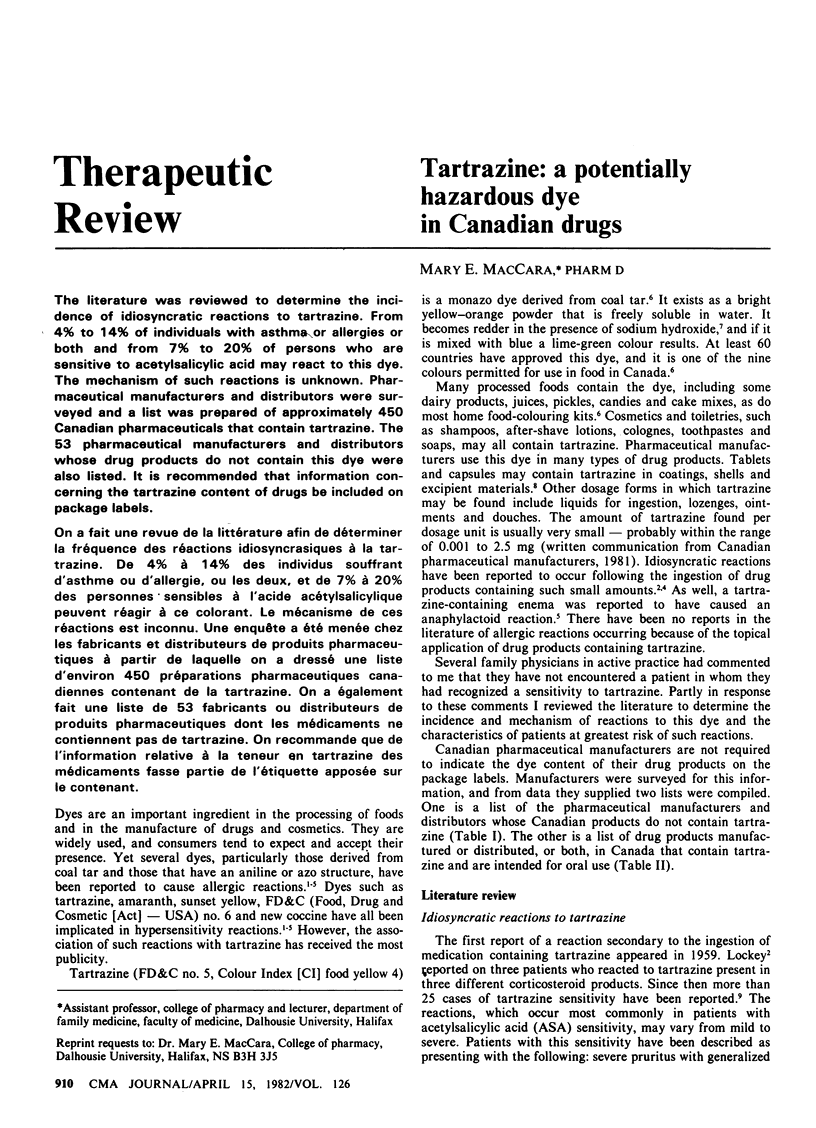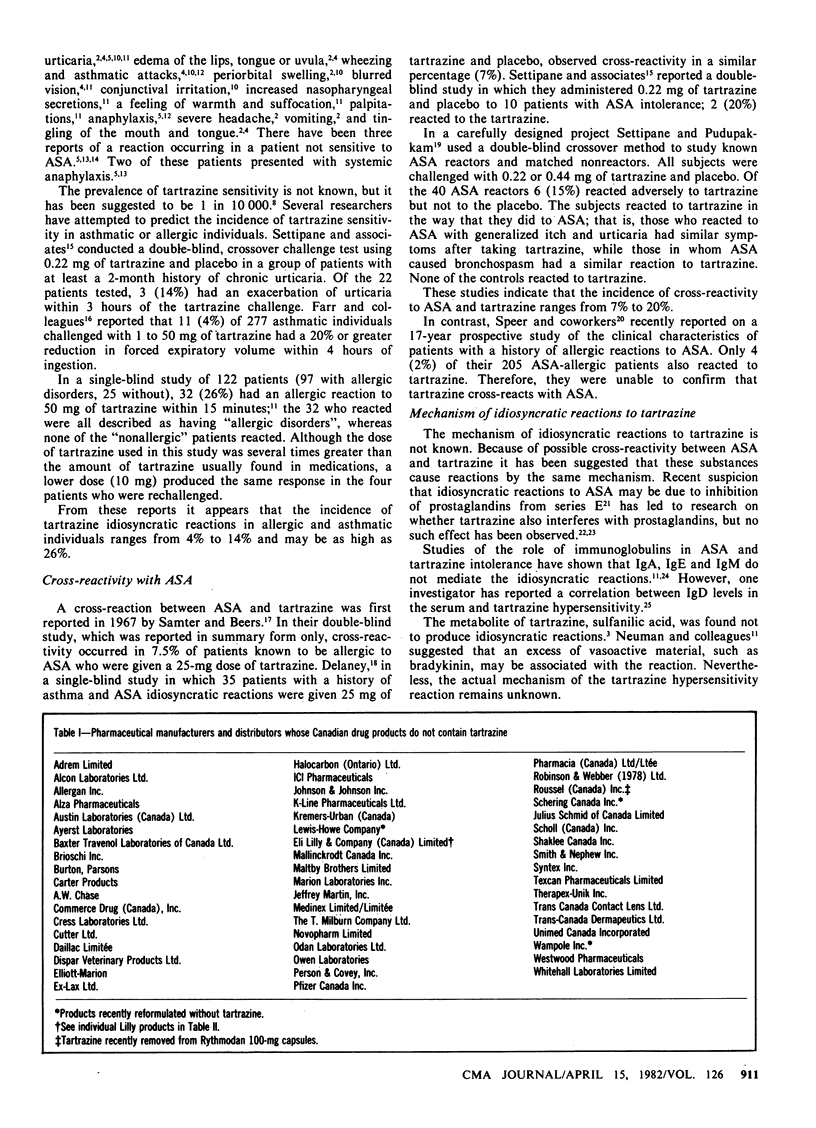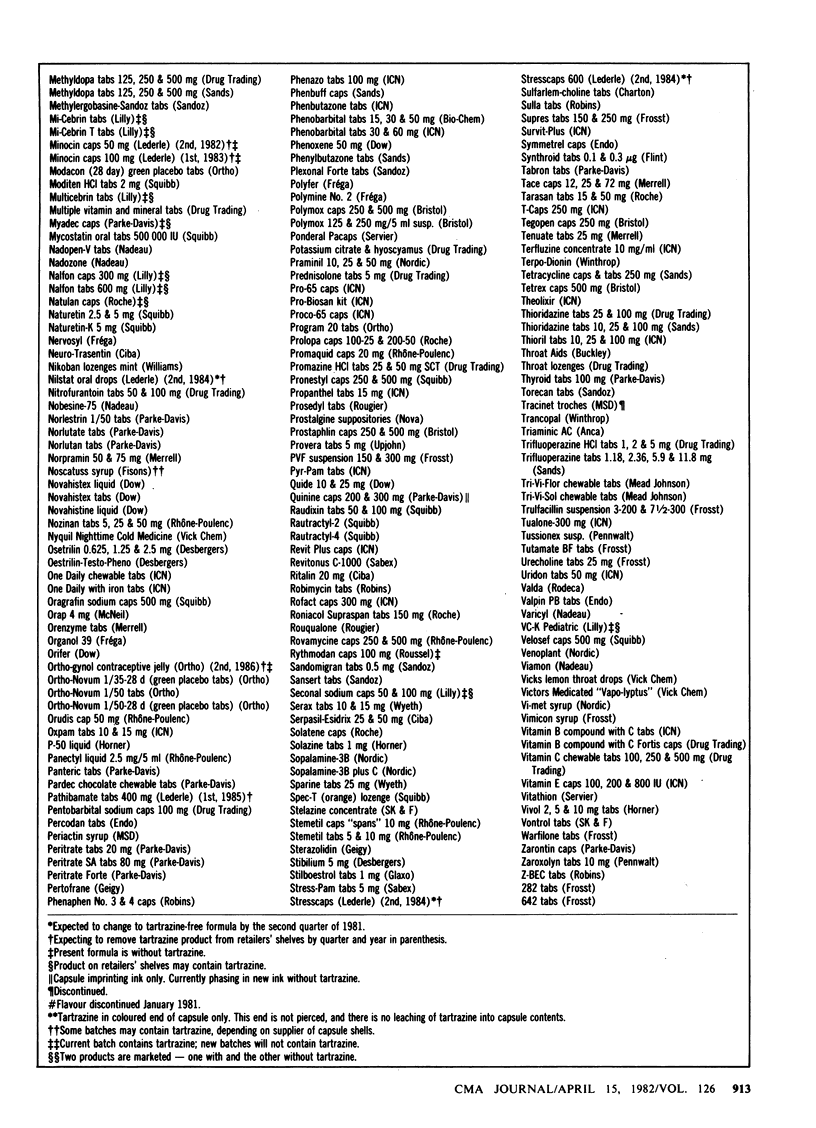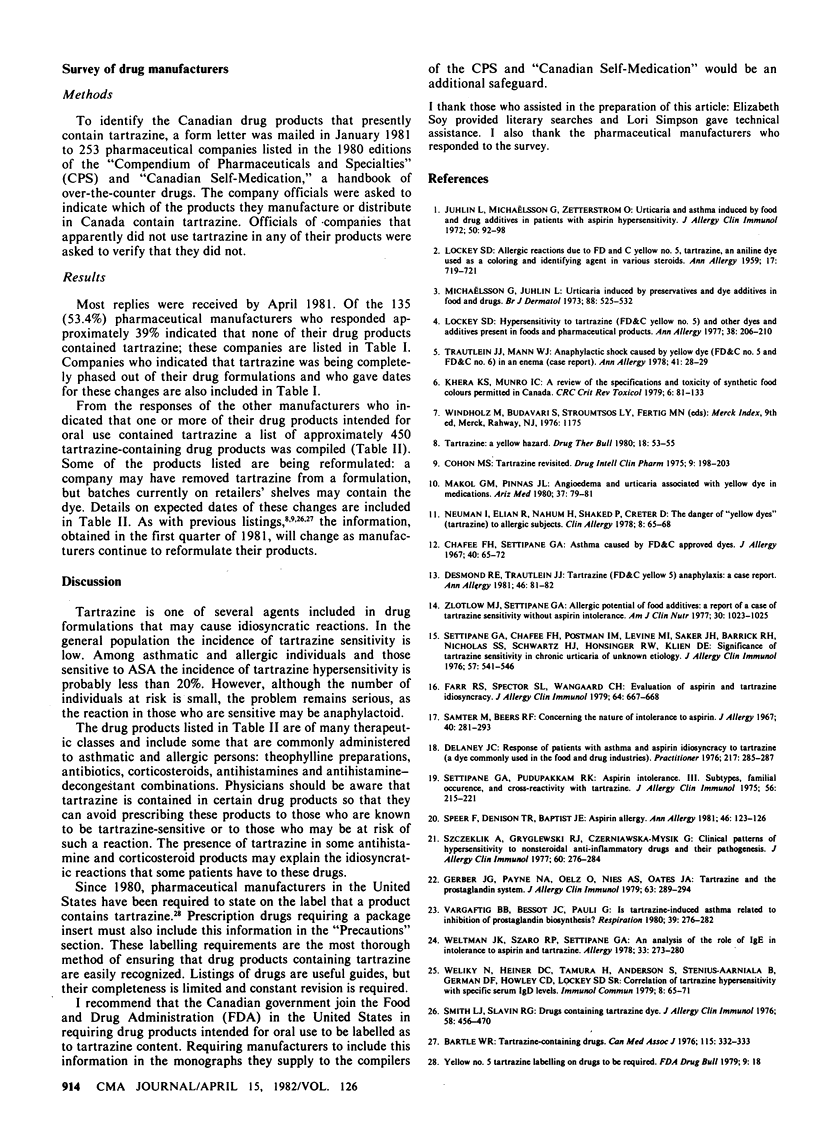Abstract
The literature was reviewed to determine the incidence of idiosyncratic reactions to tartrazine. From 4% to 14% of individuals with asthma or allergies or both and from 7% to 20% of persons who are sensitive to acetylsalicylic acid may react to this dye. The mechanism of such reactions is unknown. Pharmaceutical manufacturers and distributors were surveyed and a list was prepared of approximately 450 Canadian pharmaceuticals that contain tartrazine. The 53 pharmaceutical and manufacturers and distributors whose drug products do not contain this dye were also listed. It is recommended that information concerning the tartrazine content of drugs be included on package labels.
Full text
PDF




Selected References
These references are in PubMed. This may not be the complete list of references from this article.
- Bartle W. R. Tartrazine-containing drugs. Can Med Assoc J. 1976 Aug 21;115(4):332–333. [PMC free article] [PubMed] [Google Scholar]
- Chafee F. H., Settipane G. A. Asthma caused by FD&C approved dyes. J Allergy. 1967 Aug;40(2):65–72. doi: 10.1016/0021-8707(67)90099-8. [DOI] [PubMed] [Google Scholar]
- Delaney J. C. Response of patients with asthma and aspirin idiosyncrasy to tartrazine (a dye commonly used in the food and drug industries). Practitioner. 1976 Aug;217(1298):285–287. [PubMed] [Google Scholar]
- Desmond R. E., Trautlein J. J. Tartrazine (FD & C yellow #5) anaphylaxis: a case report. Ann Allergy. 1981 Feb;46(2):81–82. [PubMed] [Google Scholar]
- Farr R. S., Spector S. L., Wangaard C. H. Evaluation of aspirin and tartrazine idiosyncrasy. J Allergy Clin Immunol. 1979 Dec;64(6 Pt 2):667–668. doi: 10.1016/0091-6749(79)90035-6. [DOI] [PubMed] [Google Scholar]
- Gerber J. G., Payne N. A., Oelz O., Nies A. S., Oates J. A. Tartrazine and the prostaglandin system. J Allergy Clin Immunol. 1979 Apr;63(4):289–294. doi: 10.1016/0091-6749(79)90115-5. [DOI] [PubMed] [Google Scholar]
- Juhlin L., Michaëlsson G., Zetterström O. Urticaria and asthma induced by food-and-drug additives in patients with aspirin hypersensitivity. J Allergy Clin Immunol. 1972 Aug;50(2):92–98. doi: 10.1016/0091-6749(72)90004-8. [DOI] [PubMed] [Google Scholar]
- Khera K. S., Munro I. C. A review of the specifications and toxicity of synthetic food colors permitted in Canada. CRC Crit Rev Toxicol. 1979 Jan;6(2):81–133. doi: 10.3109/10408447909113047. [DOI] [PubMed] [Google Scholar]
- LOCKEY S. D. Allergic reactions due to F D and C Yellow No. 5, tartrazine, an aniline dye used as a coloring and identifying agent in various steroids. Ann Allergy. 1959 Sep-Oct;17:719–721. [PubMed] [Google Scholar]
- Lockey S. D., Sr Hypersensitivity to tartrazine (FD&C Yellow No. 5) and other dyes and additives present in foods and pharmaceutical products. Ann Allergy. 1977 Mar;38(3):206–210. [PubMed] [Google Scholar]
- Makol G. M., Pinnas J. L. Angioedema and urticaria associated with yellow dye in medications. Ariz Med. 1980 Feb;37(2):79–81. [PubMed] [Google Scholar]
- Michaëlsson G., Juhlin L. Urticaria induced by preservatives and dye additives in food and drugs. Br J Dermatol. 1973 Jun;88(6):525–532. doi: 10.1111/j.1365-2133.1973.tb08014.x. [DOI] [PubMed] [Google Scholar]
- Neuman I., Elian R., Nahum H., Shaked P., Creter D. The danger of "yellow dyes" (tartrazine) to allergic subjects. Clin Allergy. 1978 Jan;8(1):65–68. doi: 10.1111/j.1365-2222.1978.tb00449.x. [DOI] [PubMed] [Google Scholar]
- Samter M., Beers R. F., Jr Concerning the nature of intolerance to aspirin. J Allergy. 1967 Nov;40(5):281–293. doi: 10.1016/0021-8707(67)90076-7. [DOI] [PubMed] [Google Scholar]
- Settipane G. A., Chafee F. H., Postman I. M., Levine M. I., Saker J. H., Barrick R. H., Nicholas S. S., Schwartz H. J., Honsinger R. W., Klein D. E. Significance of tartrazine sensitivity in chronic urticaria of unknown etiology. J Allergy Clin Immunol. 1976 Jun;57(6):541–546. doi: 10.1016/0091-6749(76)90004-x. [DOI] [PubMed] [Google Scholar]
- Settipane G. A., Pudupakkam R. K. Aspirin intolerance. III. Subtypes, familial occurence, and cross-reactivity with tartarazine. J Allergy Clin Immunol. 1975 Sep;56(3):215–221. doi: 10.1016/0091-6749(75)90092-5. [DOI] [PubMed] [Google Scholar]
- Smith L. J., Slavin R. G. Drugs containing tartrazine dye. J Allergy Clin Immunol. 1976 Oct;58(4):456–470. doi: 10.1016/0091-6749(76)90189-5. [DOI] [PubMed] [Google Scholar]
- Szczeklik A., Gryglewski R. J., Czerniawska-Mysik G. Clinical patterns of hypersensitivity to nonsteroidal anti-inflammatory drugs and their pathogenesis. J Allergy Clin Immunol. 1977 Nov;60(5):276–284. doi: 10.1016/0091-6749(77)90106-3. [DOI] [PubMed] [Google Scholar]
- Trautlein J. J., Mann W. J. Anaphylactic shock caused by yellow dye (FD & C No. 5 and FD & C No. 6) in an enema (case report). Ann Allergy. 1978 Jul;41(1):28–29. [PubMed] [Google Scholar]
- Vargaftig B. B., Bessot J. C., Pauli G. Is tartrazine-induced asthma related to inhibition of prostaglandin biosynthesis? Respiration. 1980;39(5):276–282. doi: 10.1159/000194228. [DOI] [PubMed] [Google Scholar]
- Weliky N., Heiner D. C., Tamura H., Anderson S., Stenius-Aarniala B., German D. F., Hawley C. D., Lockey S. D., Sr Correlation of tartrazine hypersensitivity with specific serum IgD levels. Immunol Commun. 1979;8(1):65–71. doi: 10.3109/08820137909044707. [DOI] [PubMed] [Google Scholar]
- Weltman J. K., Szaro R. P., Settipane G. A. An analysis of the role of IgE in intolerance to aspirin and tartrazine. Allergy. 1978 Oct;33(5):273–281. doi: 10.1111/j.1398-9995.1978.tb01548.x. [DOI] [PubMed] [Google Scholar]
- Zlotlow M. J., Settipane G. A. Allergic potential of food additives: a report of a case of tartrazine sensitivity without aspirin intolerance. Am J Clin Nutr. 1977 Jul;30(7):1023–1025. doi: 10.1093/ajcn/30.7.1023. [DOI] [PubMed] [Google Scholar]


